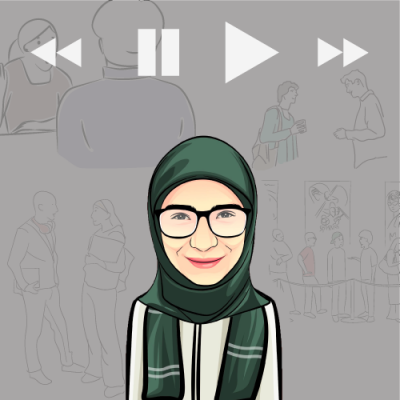 |
Listening Skills for Language Proficiency Anna-Maria Ramezanzadeh |
It was a huge honour being introduced to Anna-Maria while she was carrying out her doctoral research into engagement and motivation of secondary school students studying Arabic.
She kindly agreed to an interview about Arabic language teaching and learning and the following is a short clip dealing with listening skills.
Anna-Maria is now part of the team at Arabic Workshop. We’re really looking forward to building an amazing resource, grounded in solid research and hope this will raise the bar for learning and teaching Arabic Language.
TRANSCRIPT
My name is Anna Maria and I am an Arabic instructor and DPhil researcher at the University of Oxford. I currently teach Arabic to graduate and undergraduate students in various different departments and through this research I’ve been focusing on motivating Arabic language learners and engaging them in the learning process in ways that will keep them in the classroom, attract them into the classroom but also to make that whole process of learning what is often presented as a difficult language much more enjoyable and maintainable.
Listening is often an overlooked dimension in language learning and is often seen as a passive process whereby a person sits, lets language wash over them and hopefully something will happen. In reality it is an active process and a receptive skill that a person needs to develop in order to become an effective listener and an effective language learner and user.
Forty percent of our day-to-day interactions in any language consist of listening. So by ignoring listening, which is what often happens in many language learning environments, or by not giving listening the importance that it deserves, we actually cut out a huge amount of what actually happens in language use.
In addition to being overlooked as a skill in language learning, when it is addressed, listening is often seen as very, very difficult, partly because the language learner or user has very little control over the input. So you can’t if you’re talking to a person, for example, keep pressing pause on that person or keep asking… (I mean you can ask them to repeat, but only so many times). As as a result it’s often something that people will say is the area of most difficulty. When they’re asked to talk about their language learning experience, they say, for example, that you can talk to me and I might pick out a word or two but I won’t understand what you’re saying. Or that I can write really well or I can read really well but I didn’t understand anything from that two minute audio that I just heard.
The reason that listening is important, in addition to the fact that it takes up so much of our time in a language, is that there is a high correlation between listening proficiency (so how good you are, how fluent you are and how accurate you are in a language) and your overall proficiency. There’s a lot of spillover between how well you perform in a listening exercise for example, or in a listening interaction, and how well you can speak the language. In order to speak well you need to listen while and in order to do that you need to build up listening skills.
In addition there’s evidence to suggest that listening skills and listening proficiency assist in reading comprehension and spelling.
Even if your goal through language learning is just to be able to read and write the language, there are studies that show that exposing yourself to aural input, so listening resources, has a greater impact on your vocabulary acquisition and your comprehension, making it easier to retain words and boosting your overall proficiency even in reading and writing, than just looking at words on a page. Multimodal input which integrates images, text and audio material is much more effective than unimodal input, which for example, would consist of just words on a page in isolation without any images or accompanying audio.






